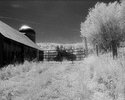Thomas Bertilsson
Member
I'm glad you know how to wash prints. With that I'm completely out of suggestions, since contamination of prints usually occurs when they are not washed properly.
Good luck with solving your problem.
Good luck with solving your problem.
Guys, it's not the wash; give that one up already or do the diffusion-rate calculations and go argue in a washing thread. This is RC and not FB, you don't need to drown it for two hours and residual-hypo testing shows that my prints are sufficiently washed or maybe even over-washed. PE: I'm not talking about film; that gets a 10+ minute wash with about 20 changes (much more than the Ilford method suggests), and the water comes out completely clear by about halfway through. My film bases are completely clear, no trace of pink/purple/etc in Acros/TMY. Believe me, I can wash stuff.
As to "why Jobo?", it's space constraints. I can process 20x24" in it no worries but couldn't even put down two trays of that size. If I'm making lots of 8x10", I can process 6 at a time in it. It's not inefficient or ineffective, it uses less chemistry and it means I can work in my laundry with just a 650x2500mm bench that holds sink, Jobo and enlarger. And I can process C41+RA4 with good process control and no dying of fumes or amine sensitisation.
It's not contamination from the back of the print behind because the top print on each pile was often the worst affected. If it were fixer contamination from when the prints were originally processed, why did they keep absolutely perfectly for 5-6 years in the very same piles before I added any Sistan?
There are no ozone sources in the building, not even a CRT. Again, no degradation on prints stored in boxes for 5+ years without Sistan.
I'm buying a squeegee for my RC, re-printing a bunch of stuff on FB and calling it a day I think.







